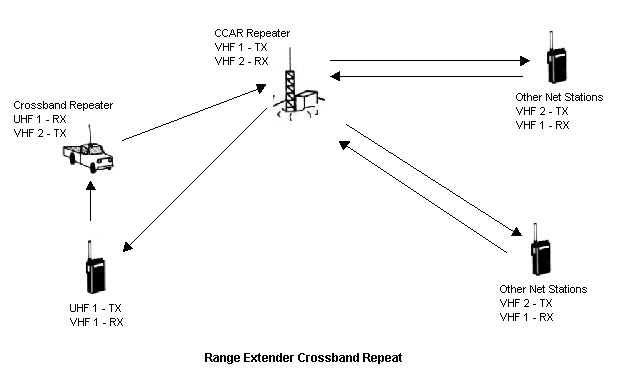 |
Crossband Repeater Operation Craig LaBarge, WB3GCK |
 |
Crossband Repeater Operation Craig LaBarge, WB3GCK |
[The information provided here was originally compiled for use by the Chester County (PA) ARES/RACES organization. -- Craig]
Operational Scenario:
A dual-band mobile rig capable of being configured as a simplex cross-band repeater (CBR) can be a useful tool during CCAR activation or public service events where net operations are being conducted on a 2 meter simplex frequency. The CBR effectively translates back and forth between a 2m simplex channel and a 70cm simplex channel. Thus, a low-power 70cm HT can work through a mobile CBR station to communicate with a 2m simplex net, taking full advantage of the mobile rig's hi-power capabilities. Any dual-band or dedicated 70cm HT can be used to operate through a CBR.
Some situations where CBR operation may be useful:
Mobile Rig Configuration:
There is no common setup for all manufacturers. Consult your owners manual for instructions for your specific radio. The following procedure is based on the Yaesu FT-8100:
HT Configuration:
Caution: When more than one CBR is being used within a net, interference may be encountered. Make sure each CBR is configured to use a different 70cm simplex frequency. Coordinate your choice of frequencies with the Net Control Station to avoid interference to the net.

Operational Scenario:
Also known as One-Way Cross Band Repeat, the range extender mode can be used when an HT has insufficient transmit power to bring up the CCAR repeater during an activation or public service event. In this mode, the mobile rig is configured as a one-way simplex repeater, receiving a 70cm simplex signal and retransmitting it out on the CCAR 2-meter repeater’s input frequency. The HT monitors the CCAR 2-meter repeater output frequency directly. Thus, to set up in this configuration, an HT capable of operating on both 2-meters and 70cm simultaneously is required.
Mobile Rig Configuration:
There is no common setup for all manufacturers. Consult your owner’s manual for instructions for your specific radio. The following procedure is based on the Yaesu FT-8100. The procedure is similar to that of the Simplex-to-Simplex CBR mode with the following modifications:
HT Configuration:
Caution: When more than one CBR is being used within a net, interference may be encountered. Make sure each CBR is configured to use a different 70cm simplex frequency. Coordinate your choice of frequencies with the Net Control Station to avoid interference to the net.

Before setting up a cross-band repeater capability, make sure you are familiar with the FCC regulations which govern repeaters and "remote bases." To make these operations fully compliant with FCC regulations, there are a few points which need to be considered. Two of the major requirements are discussed below..
Station Control
The FCC requires that a repeater be under the control of an operator who controls the repeater and can intervene in the event of a problem. Control can either be local (i.e., "the use of a control operator who directly manipulates the operating adjustments in the station to achieve compliance with the FCC rules") or remote ("the use of a control operator who indirectly manipulates the operating adjustments in the station through a control link to achieve compliance with the FCC Rules"). In the scenarios described above, the user is likely to be within fairly close proximity to the CBR and able to directly monitor and control it. In this case, the CBR could be considered locally-controlled, satisfying the station control requirements.
Station Identification
An unattended station needs to be identified on all frequencies on which it transmits. When the user identifies on the UHF uplink, the CBR is also identifying itself on the VHF side. However, many radios do not have the capability in CBR mode to identify on the UHF downlink (transmit) side (or the VHF side, for that matter). Additionally, when another operator transmits on the UHF uplink, the CBR won't be correctly identified on the VHF side, either. So, depending on your radio, some sort of add-on device for automatic identification may be required for full FCC compliance.